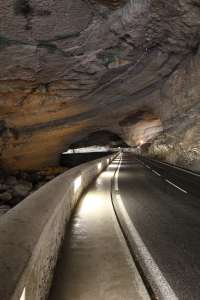Unrealized Proposal for NESTED VOIDS: LA GROTTE DU MAS D’AZIL Bradley Pitts, 2010
The cave of Le Mas-d'Azil (la grotte du Mas d'Azil), FR, was one of the first prehistoric caves to yield evidence of human habitation. Its main feature is a 500-metre natural tunnel, 51–20m high and 48-30m wide, which, since the 18th century, has housed the main road connecting Le Mas d’Azil with locations to the south.
NESTED VOIDS: LA GROTTE DU MAS D’AZIL proposes to permanently reinstall darkness in the cave, while maintaining the functionality of the existing roadway lighting. By doing this, the project seeks to reconcile the timelessness of the cave with the current inhabitation of it.
In order to realize the installation, the existing florescent bulbs along the roadway inside the cave will be removed and replaced with customized LED light bulbs. The light from these new bulbs will switch on/off every 200th of a second. In the same way that the flashing frames of a film projection or TV produce a constant image to the eye, the lights will appear to be continually lit, but on average the cave will exist in its natural, unilluminated state half of the time. In order to view the dark moments, a video camera system will be installed. These cameras will be synchronized with the lighting such that during the exposure of each video frame, the lights will be off. The resulting video will reveal the natural shadows of the cave, interrupted only by the headlights of cars passing through. When viewing the live video presented on monitors in the cave, these dark moments will be stitched together, making both the lit and unilluminated cave exist concurrently.
By simultaneously experiencing the cave’s natural, dark existence and our illumination of it, we begin to feel the context of our present. While the rocks of la grotte du Mas d’Azil have existed for roughly 65 million years, human habitation seems to have started only 17,000 years ago. We consider the prehistoric Azilians and Magdalenieans to have been temporary inhabitants of the cave, but we are tempted to think of our presence as permanent. The experience of NESTED VOIDS: LA GROTTE DU MAS D’AZIL reinforces the geological timescale lurking below the surface, reminding us that we merely occupy the most contemporary of a series of fleeting moments.
Unrealized Proposal for NESTED VOIDS: LA GROTTE DU MAS D’AZIL Bradley Pitts, 2010
The cave of Le Mas-d'Azil (la grotte du Mas d'Azil), FR, was one of the first prehistoric caves to yield evidence of human habitation. Its main feature is a 500-metre natural tunnel, 51–20m high and 48-30m wide, which, since the 18th century, has housed the main road connecting Le Mas d’Azil with locations to the south.
NESTED VOIDS: LA GROTTE DU MAS D’AZIL proposes to permanently reinstall darkness in the cave, while maintaining the functionality of the existing roadway lighting. By doing this, the project seeks to reconcile the timelessness of the cave with the current inhabitation of it.
In order to realize the installation, the existing florescent bulbs along the roadway inside the cave will be removed and replaced with customized LED light bulbs. The light from these new bulbs will switch on/off every 200th of a second. In the same way that the flashing frames of a film projection or TV produce a constant image to the eye, the lights will appear to be continually lit, but on average the cave will exist in its natural, unilluminated state half of the time. In order to view the dark moments, a video camera system will be installed. These cameras will be synchronized with the lighting such that during the exposure of each video frame, the lights will be off. The resulting video will reveal the natural shadows of the cave, interrupted only by the headlights of cars passing through. When viewing the live video presented on monitors in the cave, these dark moments will be stitched together, making both the lit and unilluminated cave exist concurrently.
By simultaneously experiencing the cave’s natural, dark existence and our illumination of it, we begin to feel the context of our present. While the rocks of la grotte du Mas d’Azil have existed for roughly 65 million years, human habitation seems to have started only 17,000 years ago. We consider the prehistoric Azilians and Magdalenieans to have been temporary inhabitants of the cave, but we are tempted to think of our presence as permanent. The experience of NESTED VOIDS: LA GROTTE DU MAS D’AZIL reinforces the geological timescale lurking below the surface, reminding us that we merely occupy the most contemporary of a series of fleeting moments.

